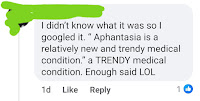Further addendum to the Aphantasia post
This blog is not called 'Laws of the Fox" or "Decrees of the Fox". I don't claim to know everything, I just try to learn about the world through a bit of observation, some thoughts and theories, then a bit more observation to see if those ideas hold water. If they do, my theories gain a bit more credence, if they don't I look for new ideas. It's basically scientific method, and over the years I've shifted my views on many topics.
I don't get a whole lot of discussion here, but I shared the post in a couple of Facebook groups and got all sorts of insight. My knowledge about aphantasia has expanded somewhat as a result of these new discussions and observations, but one if the key lessons learnt is that the word "aphantasia" seems to describe a few interrelated conditions that are being conflated, and there is still a lot of research to do regarding mental visualisation and the shared imaginary experience of RPGs (or even play in general).
Some of the feedback made for some great talking points and conversation. This was actually really good because it has basically forced me to reassess my perspective of aphantasia. This meant that with a number of people indicating that they enjoy roleplaying games with aphantasia, I can no longer really say that the condition prevents people from engaging in the imagined space. A few people offered suggestions on how they manage to engage with the developing narrative, or how people they play with manage to connected with the experience.
I posed the question in a few groups from the standpoint of designing a game for folks with aphantasia, rather than a narrator running games for folks with this condition. This really seems to be where the differences lie, and since I'm a firm believer that there's no "wrong" way to roleplay, it's all about adjusting the play experience to maximize the potential for players like this. So maybe my players that are having trouble engaging the narrative development are having completely different issues.
There's a lot to unpack in the one above. Yes, school tends to stifle creativity, but a lot of this comes down to the whole nature versus nurture debate. How much of a player's inability to engage the narrative comes from genetic conditions and hardwiring of the neural circuitry, and how much is lost opportunity for the development of these skills.
So, is it "pawn stance", or is it some other kind of immersion that the Forge models just don't accommodate because they didn't consider the idea of immersing through different means. From a different perspective, I've often described Tabletop RPGs as being similar to improvisational jazz. Everyone knows the general rules, but everyone is also able to add their own notes into the mix. Sometimes those notes work, and a riff can send the tune in a new and unexpected direction, sometimes an unexpected note is reined in and becomes an anomaly in the overall structure before the flow goes back to its original course.
There were also a set of side conversations about which types of games might be better adapted to helping those with aphantasia, many of which suggested the best group of games were NOT "Powered by the Apocalypse".
My ideas were general stabs in the dark based on what I've seen, but I think there's a lot more research to do here.












.png)

Comments